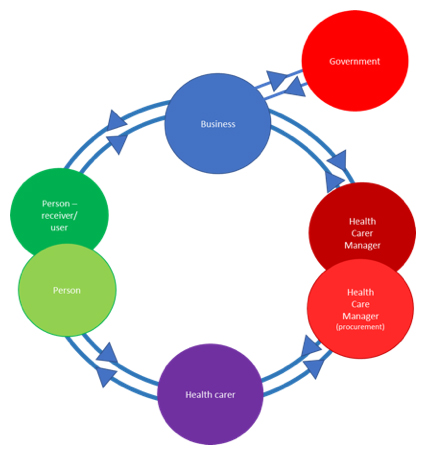It’s time for new language in healthcare marketing

Healthcare brands need some new terminology and new models. Much of the current terminology for target audiences is no longer really fit for purpose: many of the maps are still rooted in old fashioned FMCG thinking.
Starting with naming; ‘Healthcare Professionals’ is perhaps one term that could stay, though I have heard some cynics say that it includes many who aren’t professional in either sense of the word. They are either unqualified or their behavior is less than truly ‘professional’.
In a recent post on physiciansweekly.com the point was made by one doctor that: “Most doctors truly put patients’ care first, before profit. But, there are a few who inappropriately use their medical degrees for profit. Just look at Dr. Oz trying to get rich promoting weight loss products with no proven benefit. These doctors make us all look bad.”
It is also less clear whether it is the right term for certain managerial roles, including procurement specialists, who can be important target groups and very much part of the pathway to purchase and usage.
There are more problems with the notion of ‘Patients’. Patients are no longer patient and reactive. For some MedTech clients I have spoken to, the term reflects an “old school” attitude; one of passivity; somebody waiting to have something ‘done’ to them.
This isn’t true of many people today, who are highly proactive and don’t like waiting. There are an increasing number of people who are either taking more control of their own health or are getting much ‘better’ informed about their ‘problems’ before visiting their doctors or hospitals. Although it is of course true that some of these just think they are better informed when they are in truth much better ‘misinformed’.
The term also doesn’t cover people with a condition before they become a ‘patient’ i.e. they truly only become patients only when start consult with HCPs and are in some form or other therefore under care. These are ‘people with the condition’ rather than patients.
‘Consumer’ is still used in OTC markets and is challenged not just in healthcare but in many other ‘consumer-good-markets’. It reflects a 1950s perspective on the brand-user relationship, focusing on the act of consumption and a parent-to-child communication model.
Its weaknesses also include the fact that the purchaser isn’t always the consumer. Think about the many instances where the parent is getting care or medicines for their child or a ‘carer’ is acting on behalf of someone else.
As in other markets, there is a recognition that users of services are not so much ‘consumers’ as ‘customers’ because they don’t just consume – use up – a physical product. The use of ‘customer’, however, can be confusing as ‘customers’ has often been used to describe the intermediary, the trade, the pharmacy, the hospital, the procurement manager etc.
This then further impacts on thinking about the multi-layered, multi-stage targeting and purchase path that health brands travel. This is something which most medical marketing does recognise, but where the usage of traditional and over-simplified marketing jargon means that the description of the journey is often out of date. There is a danger this can lead to over-simplified thinking because everyone wants everything to be simple but, as medical science proves time and time again, not everything is simple.
Medical marketing isn’t just a simple equivalent of traditional marketing’s b2c or b2b or even b2b2c models. It (using old language) can be b2g2b2b2hcp2p - business 2 government (approval) 2 business (hospital/doctors’ practice) 2 businesses’ procurement 2 hcp (the user/giver of care) 2 ‘patient’. And all of these tend to be linear or at best circular models which don’t reflect that communication is now much more of a two-way conversation, not a one-way monologue.
So how might the industry move forward?
Starting with some thoughts on new nomenclature. The easiest win is that ‘Healthcare Professionals’ could be kept as a general term. It might be worth differentiating between Health Carers and Healthcare Managers, though it’s important to recognise that some managers will also be carers.
A simplified and maybe simplistic view on the knotty question of ‘Patient’ is that they are not just patients but ‘people’. It is a more modern and perhaps more respectful term. It’s people with diabetes, not diabetes patients.
‘Customers’ can be used for healthcare providers, but the notion of the intermediaries might be more useful as a broad term, which could then be segmented into other sub-groups.
And then considering models, it is worth noting that other classic marketing models have already been adapted for the industry. For example, traditional product lifecycle models have been extended to reflect the reality of most drug lifecycles. The newer medical product models include a pre-launch phase to cover development, trials and regulatory approval and also have a post-patent expiration period.
The path to purchase model for medicines now needs to evolve from a unidirectional one-way model to more circular multi-directional model, perhaps something akin to what is shown below (though even this has been simplified enormously.)

And finally, if you think naming or rather renaming isn’t important just ask Maurice Micklewhite or Marion Morrison (if you don’t know – look them up) and consider how most research is now called insight and how brand mission is becoming ‘brand purpose’.
About the author
Giles Lury is a director at brand and marketing consultancy The Value Engineers (part of the Cello Health Group), and author of six books on marketing. He is a regular contributor to numerous marketing publications and website including The marketing Society.


